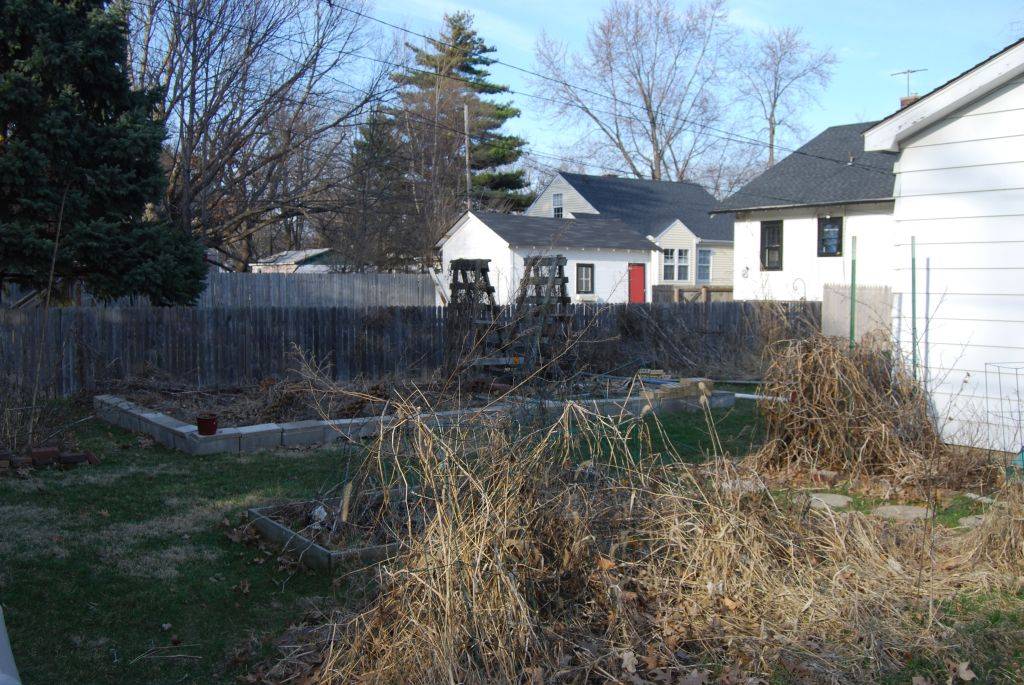 It had been an excellent couple of days in Chicago seeing Mazes and Soundtrack of Our Lives, but the promise of early-vegetable planting weather in C-U for the remainder of the weekend (plus the orange galoshes I found in a resale shop on North Avenue) made getting home Saturday afternoon, a priority in order to prep for Sunday planting.
It had been an excellent couple of days in Chicago seeing Mazes and Soundtrack of Our Lives, but the promise of early-vegetable planting weather in C-U for the remainder of the weekend (plus the orange galoshes I found in a resale shop on North Avenue) made getting home Saturday afternoon, a priority in order to prep for Sunday planting.
See, the weather is absolutely perfect right now to start a few really early vegetables by sowing seeds directly into the ground — no indoor seed starting necessary. This extra-warm weather is flukey and can trick some folks into planting seeds that shouldn’t be planted; looking at forecasts a couple weeks out, I’m gathering that temperatures will be in the 50s and damp, balanced out with some sunshine — not a lot, but enough. This is PERFECT spinach, pea, radish, beet, and chard weather — all of these things can be planted now and will be fine even if the temps go way down at night or if we get snow. (One year I planted my peas in late February/early March and it was wild seeing them poke out of a couple of inches of snow a few weeks later. They don’t really mind, though.)
If you’re starting warmer weather seeds (tomato, pepper, flowers, and annual herbs) for eventual container gardening or to transplant into garden beds, now’s the time to set up your lights and trays (or just trays, if you have a sunny window and your pets won’t bother seedlings). There are many different ways to set up seed-starting rigs, but here’s what I use, since I don’t have a sunny window:
- Shop light fixtures (you can get one of these at any hardware store)
- Regular old fluorescent light bulbs to fit the fixtures
- Little chains to hang the lights with
- Seed starting mix (available at any garden store or large grocery store, especially now)
- Seed trays and cell packs (available in the same place as the the seed starting mix as a package deal, or you can make your own pots)
- Labels (so you know which seeds are planted in which pots or cells)
- Spray bottle
- Seeds (I just read an article mentioning Recession Gardens’ popularity — some places are running low on seeds, but you should be able to find what you need at local garden stores or wherever you found the trays)
Here’s what I do. You can modify this to suit your own needs or situation:
1. I rig the lights so they are suspended, using the little chains, from the bottom of a wire shelf and hang just above the seed tray below them.
2. Using a spoon, I load up the cell packs or pots with seed starting mix.
3. Then I put a seed or two (some of the tomatoes I have this year are limited in seed quantity, so I’ll be starting one seed per cell or pot for those, but for the others I’ll use two seeds per cell/pot) into each cell/pot. I usually start tomatoes, basil, peppers, and some flowers like zinnias all at the same time, while vegetables like peppers prefer warmer conditions to germinate than the conditions in my basement. (They’ll germinate anyway — it’ll just take longer.)
4. Then I press down gently so the seed is covered with mix, but isn’t too deep.
5. I label everything, or draw a map of what I’ve just planted.
6. Then I put about ¼” of water into the seed tray.
7. I mist the top of the seed starter mix until things are looking quite wet (but not soggy).
8. I place the tray(s) on a shelf and turn on the lights
I usually leave the lights on 24 hours a day until the first seeds germinate; then I turn the lights on when I get up and shut them off when I go to bed. The light should always be adjusted to be as close as possible to the seedlings, but never touching. That’s where the chains come in handy. I add water to the tray whenever it gets dry (check daily), but stop misting once the seeds germinate to avoid mildew.
Next column, I’ll write about what to do with your seedlings once they become wee little plants.
So — now is a good time to:
- Start warmer weather seeds (tomatoes, peppers, herbs, lettuces, etc.) indoors, under lights or using the sun
- Plant cooler weather stuff directly into the ground
- Buy plenty of seeds for direct-seeding once it stays warm (beans, sunflowers, cucumbers/melons, etc.)
- Start finding clear gallon milk jugs to use as makeshift cloches for your tomato and other seedlings (more about what this means next column)
- Figure out what kind of support system your tomatoes will need (purchased cages, home-built cages, trellis, etc.), because they will need one
- Perform any garden cleanup tasks you may have failed to do last fall and take your yard waste (and your neighbors’), if any, to the Landscape Recycling Center in Urbana (or bag it up and wait for U-Cycle to come and pick it up)

It’s definitely time to get to work!








